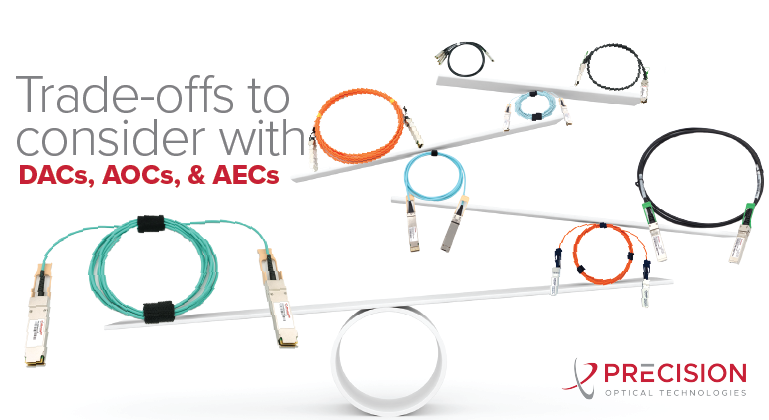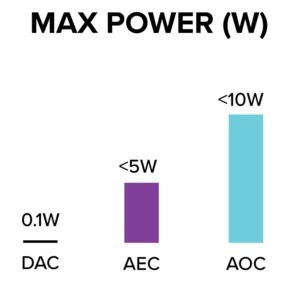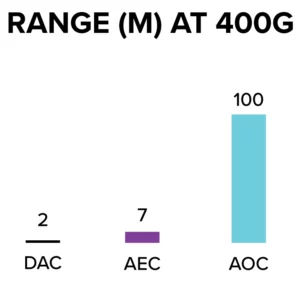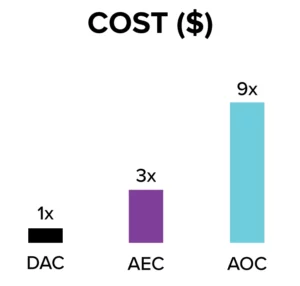
Trade-offs to Consider with DACs, AECs and AOCs

Trade-offs to Consider with DACs, AECs and AOCs
Is high density driving the development of data centers? Absolutely. As more businesses and consumers take advantage of cloud-native, data-intensive services, the principles of high-density design help data center operators do more within a given footprint. From improving space utilization to reducing operating costs, many considerations go into designing and deploying high-density data centers. One of the most fundamental decisions involves selecting the right cables to connect switches, servers and other networking equipment within the data center.
In this regard, data center operators have several options including passive Direct Attach Cables (DACs), active DACs, and Active Optical Cables (AOCs). Both passive and active variants of DACs feature copper wires that connect two fixed transceiver modules on either end without optical components. Passive DACs contain no active components, whereas AECs (a particular type of active DAC) have a retimer utilizing DSP-digital signal processing or CDR-clock data recovery. We’ll compare these 2 types of DACs to AOCs, which use multimode optical fiber connected between two fixed transceivers instead of copper wire.
Which Cable is Best for My Data Center?
Both passive and active DACs as well as AOCs function as alternatives to purchasing individual transceivers and cables separately. As with many design and engineering projects, selecting the right cables for your network is all about trade-offs. Size, power, range and cost are just some of the parameters that need to be considered in determining which cables are right for a particular application.
Power
When it comes to power consumption, it’s hard to beat the passive DAC. DACs consume <.1W which is negligible when compared to the more power-hungry AECs and AOCs as shown in the rough estimation in Figure 1.

Fig. 1 Comparison of Cable Power Consumption at 400G
Signal Integrity and Cable Management
Data centers are home to many servers, routers and switches – all generating electromagnetic interference. Because DACs use an electric signal to transmit data between both ends, it is possible that the electromagnetic interference will reduce signal quality. In this circumstance, data center operators may encounter errors on their data circuits. AOCs, on the other hand, do not encounter this problem as optical fibers are naturally immune to electromagnetic interference. They can run distances of 100 meters or possibly greater before errors might be seen in the signal. With the standard length of 50 meters, data center operators leveraging AOCs will not have issues with noise or interference.
Since electrical cables are vulnerable to electromagnetic interference from outside sources, they must have significant insulation to shield from electrical interference and ensure signal integrity. The higher the data rate and longer the length of the cable, the thicker this insulation needs to be to prevent interference. This makes the DACs bulkier and harder to install/remove than AOCs since optical cables do not need this type of insulation. AOCs are much thinner and have a much tighter bend radius than DACs making them easier to use especially in high density data centers. As mentioned in the introduction, AECs include a “re-timer” component inside the transceiver which removes noise and amplifies the signal so that less insulation is needed, and the cable can be much thinner. Less bulky cabling means better heat dissipation in/around the rack which can make a big difference in power and air-flow efficiency. Both AOCs and AECs improve air flow and reduce thermal heat by taking up less volume than DAC solutions. Note that particular care must be taken with AOCs and all kinds of embedded optical solutions to ensure they work properly. Check out our video on the proper ways to handle your fiber optic equipment.
Range
In terms of length, DACs are typically limited to a maximum length of a few meters depending on the data rate. On the other hand, AOCs can run up to a standard maximum length of up to 300 meters for up to 10G/40G applications and 100m for 25G to 400G. AOCs typically leverage OM3 and OM4 multimode cables, with OM4 fiber being backwards compatible with OM3. AOCs are versatile and capable of handling a wide range of data center applications.
Range at various data rates for DAC vs AOC:
|
|
10G |
25G |
100G |
400G |
|
DAC Max Range |
7m |
5m |
5m |
3m |
|
AOC Max Range |
300m |
100m |
100m |
100m |
The length limiting factor with DACs is that their electrical signals become quite susceptible to interference and attenuation over longer distances, no matter how much insulation is used. In terms of length, DACs are typically limited to a maximum length of a few meters depending on the data rate, so they are unlikely to be the sole cable of choice for data center providers. On the other hand, AOCs can run up to a standard maximum length of up to 300 meters for up to 10G applications and 100m for 25 to 400G. AOCs typically leverage OM3 and OM4 multimode cables, with OM4 fiber being backwards compatible with OM3.
DACs with their range limitations are unlikely to be the cable of choice for data centers as their thicker cabling makes them harder to run through tight spaces or corners. The re-timing function of AECs allows them to reach a bit farther than DACs. By far though, for >=400G applications or data centers that house equipment well over 10 meters apart, AOCs provide the greatest reach and performance as shown in Figure 2 below.

Fig. 2 Estimated DAC/AEC/AOC Range Comparison at 400G
Cost
When dealing with the high volumes of transceivers and cables needed within a data center, DAC cables provide a cost-effective alternative to AOCs and AECs. From the copper used to connect both ends to the lower cost hardware within the transceivers themselves, DACs are an excellent purchase for data center operators buying in bulk to outfit their facilities. By comparison, AOCs, which leverage fiber and other optical technology, are a more expensive choice. The cost of AECs falls somewhere in between AOCs and DACs as shown in Figure 3. Keep in mind though, the length and bend radius of DACs will be limited as mentioned above.

Fig. 3 Approximate DAC/AEC/AOC Cost Comparison
A Place for All
In our experience, data center providers may use any or all of these options: DACs, AECs and AOCs. Compared to buying individual transceivers and cables, there are some advantages to investing in cables with fixed transceivers as it saves money and time spent dealing with potentially discrepant cable lengths, panels or splicing fiber. For multi-tenant data centers, it is typical to encounter scenarios where tenants share connectivity in their racks. Some might be on DACs or AECs and others on AOCs – it is the responsibility of the provider to meet customer preference. In other cases, one might see a server going to a switch via a DAC and the switch to a router over AOC. As we move forward to higher data rates of 800G and beyond, the bend radius and range limitations of copper may necessitate the use of AOCs in most, if not all, data center applications.
As we do with all aspects of telecommunications networks, Precision OT takes a systems engineering approach toward data center connectivity. To meet various network demands, trade-offs and compatibility needs, Precision OT offers a range of DACs, AOCs and will soon offer AECs. To find out more about how we can help you with your data center connectivity requirements, contact us!






